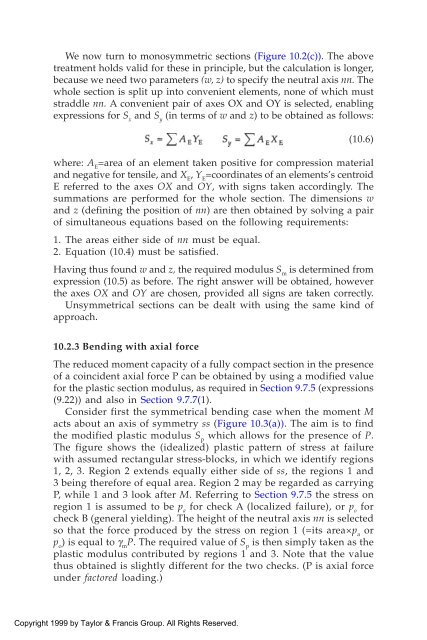Aluminium Design and Construction John Dwight
Aluminium Design and Construction John Dwight
Aluminium Design and Construction John Dwight
You also want an ePaper? Increase the reach of your titles
YUMPU automatically turns print PDFs into web optimized ePapers that Google loves.
We now turn to monosymmetric sections (Figure 10.2(c)). The above<br />
treatment holds valid for these in principle, but the calculation is longer,<br />
because we need two parameters (w, z) to specify the neutral axis nn. The<br />
whole section is split up into convenient elements, none of which must<br />
straddle nn. A convenient pair of axes OX <strong>and</strong> OY is selected, enabling<br />
expressions for S x <strong>and</strong> S y (in terms of w <strong>and</strong> z) to be obtained as follows:<br />
(10.6)<br />
where: AE =area of an element taken positive for compression material<br />
<strong>and</strong> negative for tensile, <strong>and</strong> XE , YE =coordinates of an elements’s centroid<br />
E referred to the axes OX <strong>and</strong> OY, with signs taken accordingly. The<br />
summations are performed for the whole section. The dimensions w<br />
<strong>and</strong> z (defining the position of nn) are then obtained by solving a pair<br />
of simultaneous equations based on the following requirements:<br />
1. The areas either side of nn must be equal.<br />
2. Equation (10.4) must be satisfied.<br />
Having thus found w <strong>and</strong> z, the required modulus Sm is determined from<br />
expression (10.5) as before. The right answer will be obtained, however<br />
the axes OX <strong>and</strong> OY are chosen, provided all signs are taken correctly.<br />
Unsymmetrical sections can be dealt with using the same kind of<br />
approach.<br />
10.2.3 Bending with axial force<br />
The reduced moment capacity of a fully compact section in the presence<br />
of a coincident axial force P can be obtained by using a modified value<br />
for the plastic section modulus, as required in Section 9.7.5 (expressions<br />
(9.22)) <strong>and</strong> also in Section 9.7.7(1).<br />
Consider first the symmetrical bending case when the moment M<br />
acts about an axis of symmetry ss (Figure 10.3(a)). The aim is to find<br />
the modified plastic modulus S p which allows for the presence of P.<br />
The figure shows the (idealized) plastic pattern of stress at failure<br />
with assumed rectangular stress-blocks, in which we identify regions<br />
1, 2, 3. Region 2 extends equally either side of ss, the regions 1 <strong>and</strong><br />
3 being therefore of equal area. Region 2 may be regarded as carrying<br />
P, while 1 <strong>and</strong> 3 look after M. Referring to Section 9.7.5 the stress on<br />
region 1 is assumed to be p a for check A (localized failure), or p o for<br />
check B (general yielding). The height of the neutral axis nn is selected<br />
so that the force produced by the stress on region 1 (=its area×p a or<br />
p o ) is equal to � m P. The required value of S p is then simply taken as the<br />
plastic modulus contributed by regions 1 <strong>and</strong> 3. Note that the value<br />
thus obtained is slightly different for the two checks. (P is axial force<br />
under factored loading.)<br />
Copyright 1999 by Taylor & Francis Group. All Rights Reserved.















